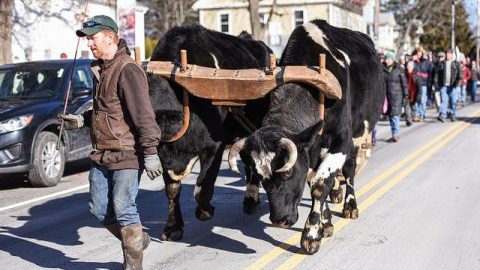On the morning of Wednesday, January 24th, crowds gathered on the icy lawn of the Historic Northampton Museum and Education Center to see a rare sight: denizens of Northampton clamored onto benches, tables and stumps to get a glimpse of Tom Jenkins’ oxen, Rocky and Star.
Tom Jenkins, of Blue Dog Forestry, stood in the shadow of his enormous working animals, which weigh in at a combined 5,000 pounds. The oxen stood calmly awaiting a command, unfazed by the mass of spectators. Together they wore an impressive elm neck yoke, which Jenkins explained is the most effective way to harness the power of his animals.
As Laurie Sanders—co-executive director of Historic Northampton and organizer of the day’s event—explained, “The event was inspired by the Historic Center’s plans to construct a new solar array on its grounds.”
The move is part as a part of a wider effort to make the organization sustainable. However, the construction necessitated the removal of two large trees; rather than simply remove the trees by conventional means, the Historic Society decided to turn their removal into a demonstration of historic logging techniques. That is where is where Jenkins and his oxen came into the picture.
The oxen team was ultimately there to haul away the timber that remained of the removed trees, but not before they demonstrated to a gathering crowd their strength and training. All watched with rapt excitement as Tom guided the oxen into position in front of a piece of pine weighing—by his estimation—between 600 and 800 pounds. The silence of the attentive crowd was broken only by their gasps of amazement and delight as the team pulled the massive log across the ground with surprising speed and no apparent effort.
The crowd grew as passersby stopped to hear Jenkins explain the rich history of the forestry of Pioneer Valley, and watch the oxen perform yet more impressive feats of strength. Finally, the oxen, listening to Jenkins’s “gees” and “haws,” loaded timber onto a simple sled which would be used to haul the wood to its final destination.
Then the parade began. The oxen team, sled in tow, skirted the edge of the lawn and made their way onto Bridge Street. A police escort awaited to clear the streets ahead of the oxen. Behind, the crowd which had previously watched the oxen move the wood up and down the lawn, flooded into the street and followed the pull team. A brisk pace was needed to keep up with the powerful animals.
When asked if it was difficult to get the city of Northampton to go along with the idea of massive animals parading though city streets, Sanders laughed and recalled that “as soon as I told the mayor the idea, he said we simply had to do it.”
The parade rounded a corner onto Hawley Street, and made their way to the site of the Northampton Community Arts Trust. The destination was picked because, as director Sanders explained, “The site of the Arts Trust was, at the peak of Northampton’s Timber Industry, an important lumberyard.”
After being pulled to the site by the oxen, they will be the medium of local artist Michael Tillyer.
Tillyer, from the Anchor House of Artists in Easthampton, intends to sculpt the pine into a statue of Sisyphus. However, he explained that “In my version of [the story of] Sisyphus, Sisyphus realizes that we can let go of our burdens, rather than continue to bear them.”
The event managed to bring together disparate parts of the Northampton community. What started as a sustainability project, turned into an educational and historical event, and eventually was an opportunity to promote the local arts.
Tom Jenkins and his oxen team compete at local fairs, including the Three County Fair in Northampton, a good opportunity for any readers that wish to see the tremendous bovine at work for themselves.
Noah Kouchekinia can be reached at [email protected].



















